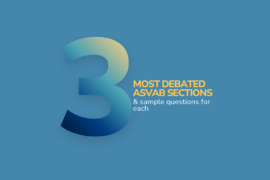GRE analytical writing assesses your ability to think critically and transfer your ideas into well-developed, well-reasoned, and well-supported writing. The GRE tests two sections of a student’s analytical writing skills: analyzing an issue and analyzing an argument. This article covers the analyzing an issue task so you can write like a non-boring academic and maximize your GRE score!
We asked our experts at Peterson’s for their advice on how to master the analytical writing section of the GRE. Here are their top 7 tips to succeed on test day.
The Analyze an Issue Task
The Issue Task assesses how well you can develop and support your own position on an issue. To respond to the Issue Take, you need to take a position either agreeing or disagreeing with an issue and defend your position with evidence.
The Issue Task prompt presents you with a brief statement on a general issue and sets the conditions you’re allowed to respond to it. It doesn’t matter whether your agree or disagree with the issue, but you must address certain surrounding issues in your response.
Our experts recommend the following:
#1 State a thesis, and state it early

Don’t make your reader guess what side of the issue you’re on, take a side and stick to it. Be completely obvious about which position you’re taking. A thesis statement that makes your view on the issue absolutely unmistakable should appear somewhere in the first paragraph.
Don’t worry about being too obvious or even leading off with your thesis. You can, in fact score a 6, the highest score, if you state your point of view in the first sentence. Make sure that the thesis is clear and that all the evidence and support you write after it goes together.
#2 Use a standard pattern of organization
ETS, the maker of the GRE, doesn’t require any particular standard pattern of organization for writing your response. But, this doesn’t give you permission to have no organization. Organizing your writing will help the reader understand your writing and help you write quicker and with more clarity. You can get a better idea of how to organize from tips three and four.
#3 Order paragraphs effectively
Once you’ve gotten your general structure, it’s time to make sure that your paragraphs go in logical order. There are a couple ways to do this:
- Rank the points you’ll write about from most to least important and write in that order.
- Go the opposite direction and write from least to most important, this is the preferred option. Writing from the least to most important point allows your to have a strong rather than weak finish. It creates a sense of rising tension and will also make your writing overall more persuasive.
#4 Use a Standard Pattern of Paragraphing

Try a traditional structure for developing the paragraphs within the body of your response.
Topic Sentence
The topic sentence tells the reader what the paragraph is about. When you’re responding to the Issue Task, you can also include things like:
- Support for your position
- A point that challenges your view
- A weak spot in your view
While it’s unnecessary to include all of these in your topic sentence, choosing at least one of them will give you a more substantive position.
For example, you might argue that it’s a reasonable policy for visitors to the nation’s museums in Washington, D.C., to pay an entrance fee. Your topic sentence might suggest that by having to pay, people will place greater value on their visit (i.e. support for your position).
Support and Development
After your topic sentence, you’ll need to develop your perspective and support it. Here are three options:
- Restriction – sharpening the focus of your topic by further qualifying it or narrowing it
- Explanation – further elaborating what your position is
- Evidence – supporting your position with facts
Your job here is to make your topic sentence convincing by developing it with supporting points.
Going back to the paid-entry to national museums in Washington example: you might talk about how families visiting for a long weekend from faraway might not come if they had to pay for two adults and several children at three museums. You could emphasize the loss of first-hand access to our nation’s history for those children and how seeing, for example, the original Constitution can foster patriotism.
As you read this, you may think of counter reasons to this line of reasoning; that’s good if you do. Considering different perspectives will only help strengthen the support and development of your writing. Try to make this part of your paragraph full and dense with detail by using the above suggestions.
Final Summary or Clincher Statement
If you’re writing a body paragraph, it isn’t necessary to have a final summary or clincher statement. In general, what you need is to be able to transition to your next point at the end of each body paragraph. Still though, it helps if you can give a fresh and more enlightened perspective (i.e. in light of the support and reasoning given in the paragraph). Don’t worry about being “clever” with this sentence. Put your focus instead on emphasizing the main idea of the paragraph whether you’re writing a clincher or transition.

#5 Develop each paragraph fully
A huge factor in the success or relative failure of your essay will be the kinds and amount of support you provide. Here are 5 things you can add to create well-rounded and substantive paragraphs:
Facts
Facts are a perfect way to add support and credibility to your argument. While it’s of course important not to just make up facts in your writing, you should feel free to use some general facts. If you happen to know something about the topic you’re writing about, it’s a splendid idea to include this information. Facts are an appeal to the reader’s reason.
Authoritative Opinions or Human Interest
Appealing to someone with authority on the topic you’re writing about can help develop your piece further. While it isn’t necessary to remember a quote exactly, if you can accurately paraphrase the general idea and position of an authority figure on the topic, this is a engaging option. Be mindful if the information you’re including is an appeal to the reader’s reason or emotion. Emotional appeals, while powerful, should be used sparingly. Your writing should not solely depend on this kind of information.
Observations
We all have unique and valuable perspectives. Sharing your personal observations is a simple way to add more to your writing while lending more support to your argument. If you have a lot of life experience, this becomes even more helpful. Your observations can be an appeal to either reason or emotion.
An Anecdote
Telling a short story can memorably drive home your position while possibly adding some evidence to your claim. Remember to limit your piece to a maximum of one anecdote, otherwise you might end up detracting from your overall work. This method can work as either an appeal to reason or emotion.
Examples
Examples help illustrate ideas in meaningful ways. Feel free to use them many times throughout your writing as they add substantive support to your claims. This method is most effective as an appeal to reason.
#6 Take care with tone and person
While tone and person are not explicitly listed in scoring rubrics, it’s still smart to be mindful of how your present yourself. In order to make yourself more persuasive, the goal is to come across as reasonable and professional. Sometimes you may feel a lot of passion about what you’re writing, just make sure you aren’t crossing the line as it can be easy to sound diatribe or just plain whiney.
The convention for the kind of writing you’ll be doing on the issues task is to use the third-person perspective. This being said, don’t hold on to this convention dogmatically. There are times that using the first-person perspective (I, me, my…) is a better choice.
For example, maintaining the third-person when referring to yourself can result in strange phrases like “this writer thinks that.” This is cumbersome writing for both you and the reader. On this note, it is also unnecessary to always refer to yourself when expressing an opinion; you don’t need to always write “I think…” or “I believe…”
#7 As time permits, add extras

If you’re able to finish your writing early, go ahead and spice it up a little, but again only after you’ve finished. The goal is to have a substantive and well-supported piece of writing. Dressing up a piece that doesn’t have the basics in place will add literally, not figuratively, no benefit. Of course, this advice is easier to do if you’re taking a computer-based test but the principles remain the same. Try adding the following elements as time permits:
Interest-grabbing opening –
This is by no means necessary, but if you can include an intriguing question or surprising fact to begin your essay; it can be a terrific add-on.
Apt word choice –
- Avoid common words that don’t add substantial meaning. Examples include: really, awesome, great, interesting, unbelievable, etc… Words like this are fine if you’re writing a blog, social media post, or just speaking casually. You should avoid them in more academic and formal writing though.
- Use active verbs in place of stative verbs like was and were
- Avoid cliches like the plague
- If you can use a more precise word, by all means use it. However, the word should add meaning and clarity. Using a smart-sounding or big word just because they look supercalifragilisticexpialidocious will not help you.
Varied sentence structure –
- Use a variety of sentence lengths. If every sentence is 25-40 words, your writing will not only be harder to understand, but you’ll also make your reader exhausted. Likewise, using only short sentences will limit your ability to express more complicated ideas.
- Using an occasional question in your writing can increase reader engagement and adds variety.
- There are many ways to begin sentences, use them. Like a dull drum beat, starting every sentence the same way is boring. Try using conjunctions, prepositions, and transitions to start sentences too.
#8 [BONUS] Create your writing plan

You get 30 minutes to read the prompt and write your response. Common sense may say to start writing ASAP after reading the prompt because you have so little time. Avoid this urge as it will be your downfall. Consider taking 4-5 minutes to do prewriting instead. Prewriting lets you work much more efficiently and effectively. It gives you a chance to think through the prompt and make a plan.
You’re better off making a quick template of your thoughts and how they’ll fit together to keep yourself on track rather than scrambling to remember what you would write next in the middle of your writing. This also helps you catch any ideas that won’t work early on instead of finding out you had a terrible idea after writing half your essay.
Prewriting
There are three main parts to prewriting to get you on track and keep you there:
- Restate the prompt – Can you say what the prompt says in your own words? Being able to restate the prompt helps you make sure you understand what it says. It’s easy to read a prompt too fast and misinterpret what is being asked of you. If you don’t understand the prompt, your whole essay will suffer.
- Think about reasons on both sides of the issue – What would people who disagree with you say? This method helps let you know what the most interesting ideas in the prompt are and how you’ll want to respond to them.
- Quick Write – In one or two sentences, write your position at the top of a piece of paper. Draw a line down the middle. On the left-side write your reasons for taking this position. Using the right-side, write how someone could try to refute each of your reasons. You’ll end up with tons of reasons on both sides and it will be easier to write a substantial essay.
How can I use these tips for my GRE prep?
You may be feeling unstoppable after learning these tips, like you’ll for sure get a 6 on your test. Unfortunately it’s not that easy. The best way to make use of all the advice in this article is to practice, practice, practice. Find some practice GRE writing prompts and try applying what you just learned.
When you take the actual test, you’ll have only 30 minutes to read and response to the prompt. Expect to need more time than this to implement these ideas the first few pieces you write. If you stick to it and practice applying these tips though, you’ll get faster and that much closer to getting the grade you want on the GRE!
We hope you found this article useful. All information for this article came from Peterson’s Master the GRE General Test 2018. There is a lot more advice, insight, practice tests, writing prompts, writing tips and more inside it—so if this article helped you, then this book will give you a lot more of what you’ll need to maximize your GRE score.



